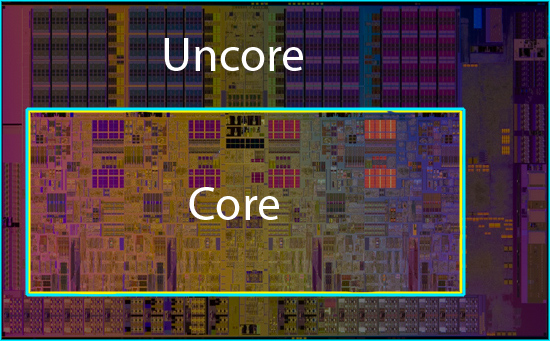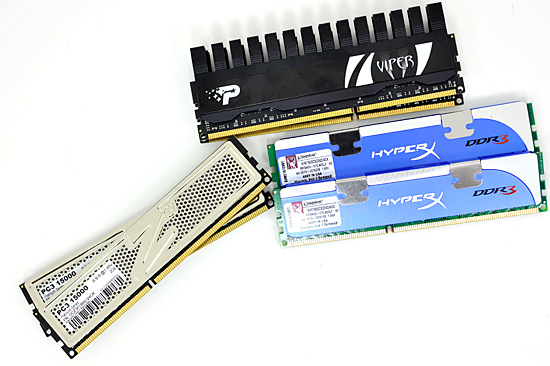Intel's Core i7 870 & i5 750, Lynnfield: Harder, Better, Faster Stronger
by Anand Lal Shimpi on September 8, 2009 12:00 AM EST- Posted in
- CPUs
Lynnfield's Un-Core: Faster Than Most Bloomfields
A few years ago I had a bet going with AMD's Ian McNaughton. We were at an AMD event where the Phenom architecture was first being introduced and he insisted that the L3 cache was part of the memory controller. This didn't make any sense to me so I disagreed. Minutes later a presentation slide went up on a projector talking about how the L3 cache and memory controller were on the same voltage plane; that's what he meant. Ian laughed a lot and to this day he holds it over my head.
The moral of the story is in Phenom and later in Nehalem, the processor is divided into two parts. Intel named them the core and the un-core. The "core" of these multi-core processors is made up of each individual processor core and its associated private caches (L1/L2). The "uncore" refers to everything else: PCIe controller, memory controller, DMI/QPI and the L3 cache.

The uncore isn't as critical for performance but is made up of a ton of transistors; roughly 400 million in the case of Lynnfield/Bloomfield (more if you count the PCIe controller). In order to save power, Intel uses slower transistors that have lower leakage for the un-core. As a result, the un-core can't clock up as high as the core and runs at a lower multiplier.
Take the Bloomfield Core i7 975 for example. The core runs at 25x BCLK (25 x 133MHz = 3.33GHz), but the un-core runs at 20x BCLK (20 x 133MHz = 2.66GHz). The rest of the chips, including Lynnfield, have slower un-cores:
| CPU | Socket | Core Clock | Un-Core Clock |
| Intel Core i7 975 Extreme | LGA-1366 | 3.33GHz | 2.66GHz |
| Intel Core i7 965 Extreme | LGA-1366 | 3.20GHz | 2.66GHz |
| Intel Core i7 950 | LGA-1366 | 3.06GHz | 2.13GHz |
| Intel Core i7 940 | LGA-1366 | 2.93GHz | 2.13GHz |
| Intel Core i7 920 | LGA-1366 | 2.66GHz | 2.13GHz |
| Intel Core i7 870 | LGA-1156 | 2.93GHz | 2.40GHz |
| Intel Core i7 860 | LGA-1156 | 2.80GHz | 2.40GHz |
| Intel Core i5 750 | LGA-1156 | 2.66GHz | 2.13GHz |
Here's another area where Lynnfield is better than the lower end Bloomfields: its uncore runs at 2.40GHz instead of 2.13GHz. The exception being the Core i5 750, its uncore is stuck at 2.13GHz as well. Once again, only the "Extreme" Bloomfields have a faster uncore.
Lynnfield's Memory Controller: Also Faster than Bloomfield
Intel only officially supports two memory speeds on Bloomfield: DDR3-800 and DDR3-1066. Obviously we're able to run it much faster than that, but this is what's officially validated and supported on the processors.
Lynnfield is a year newer and thus gets a tweaked memory controller. The result? Official DDR3-1333 support.

Three Lynnfield memory kits (left to right): OCZ, Patriot and Kingston
The same sort of rules apply to Lynnfield memory kits that we saw with Bloomfield. You don't want to go above 1.65V and thus all the kits we've seen run at 1.5V for the stock JEDEC speeds or 1.65V for the overclocked modules.

Like Bloomfield, 1.65V is the max we'll see on Lynnfield










343 Comments
View All Comments
erple2 - Tuesday, September 8, 2009 - link
[quoting]Not only did the feature that provided the least benefit (triple vs. dual channel) drive the reason for the socket/pin count difference, they gimp the platform with superior tech by cutting PCIE lanes in half[/quoting]
I thought that the X58 has the PCIe controller on the mobo, and the P55 doesn't? That the Lynnfield CPU's had a built-in PCIe controller, whereas the Bloomfields lacked the built-in PCIe controller? That appears to be another reason why intel had to make 2 separate sockets/platforms.
Now, whether that was made intentionally to force this issue with multiple platforms is a side issue (IMO). I don't necessarily think that it's a problem.
JonnyDough - Tuesday, September 8, 2009 - link
"Personally, from a consumer standpoint, I feel Intel botched the whole X58/P55 design and launch starting with the decision to go with 2 sockets. Not only did the feature that provided the least benefit (triple vs. dual channel) drive the reason for the socket/pin count difference, they gimp the platform with superior tech by cutting PCIE lanes in half."I believe it was intentional and not a botch. Intel was trying to separate a high and low end and to sell more chipsets. It's Intel being boss. It's what they do. Confuse the consumer, sell more crap, and hope that AMD stays a step behind. This is why we need AMD.
Intel is good at marketing and getting consumers to jump on the latest trend. Remember the Pentium 4? Why buy a lower ghz chip when the P4 clocks higher right?
The educated consumer waits and pounces when the price is right, not when the tech is new and seems "thrilling". This review is great but no offense it still almost seems to come with a "buy this" spin - which may be the only way a tech journalist can stay privy to getting new information ahead of the curve.
Comdrpopnfresh - Tuesday, September 8, 2009 - link
You purposefully placing the possibility of overclocking solely in the hands of the lower chip, while completely disregarding the history and facts. This-or-that logical fallacy. Third option: You can overclock the higher-clocked chip too.Granted, I see your point about the hardware being of the same generation of the architecture; that lynnnfield is not the tock to bloomfield's tick (or the other way around if how you hear clocks starts mid-cycle) and therefore the silicon has the same ceiling for OC.
But bloomfield is a like a D.I.N.K. household; dual-income-no-kids. When you overclock bloomfield, not only do you have the physical advantage of lower heat-density due to a large die, but you also don't have the whiny pci-e controller complaining how timmy at school doesn't have to be forced into overclocking. The on-die pci-e controller will hinder overclocking- period.
Just like trying to overclock cpu's in nearly identical s775 motherboards/systems. The system with the igp keeps the fsb from overclocking too much. So then what- you buy a dedicated gpu, negate your igp you spent good money on, just to have your cpu scream?
Except in this case, if one were able to disable the on-die pci-e controller and plop a gpu in a chipset-appointed slot (sticking with the igp mobo situation in s775) you'd be throwing away the money on the on-die goodies, and also throwing away the reduced latency it provides.
Has it occured to anyone that this is going to open an avenue for artificial price inflation of ddr-3. Now the same products will be sold in packages of 3's and 2's? Sorry- just figured I'd change the subject from your broken heard still stick on overclocking.
chizow - Tuesday, September 8, 2009 - link
Actually in the real world, overclockers are finding the 920 D0s clock as well and often better than the 965s for sure (being C0), and even the 975s D0. You're certainly not going to see a 5x proportionate return in MHz on the difference spent between a $200 920 and a $1000 975. There is no third option because their maximum clock thresholds are similar and limited by uarch and process. The only advantage the XE versions enjoy is multiplier flexibility, a completely artificial restriction imposed by Intel to justify a higher price tag.
philosofool - Tuesday, September 8, 2009 - link
Not seeing it dude. A little overvoltage and LGA 1156 overclocks with 1366.chizow - Tuesday, September 8, 2009 - link
Yes and early reports indicate they will overclock to equivalent clockspeeds, negating any Turbo benefit Lynnfield enjoys in the review. That leaves less subtle differences like multi-GPU performance where the X58 clearly shines and clearly outperfoms P55.puffpio - Tuesday, September 8, 2009 - link
In the article you refer to x264 as an alternative to h264in fact, h264 is just the standard (like jpeg or png) and x264 is an encoder that implements the standard. i wouldn't call it an alternative.
that would be like saying photoshop is an alternative to jpeg, becuase it can save in jpeg format
puffpio - Tuesday, September 8, 2009 - link
"You'd think that Intel was about to enter the graphics market or something with a design like this."dun dun dun! foreshadowing?
----
and since these parts consume less power yet are built on the same process, I assume they run at lower voltage? If so, since they ARE built on the same process, I'd assume they can survive the voltages of the original Bloomfield and beyond? eg for overclocking...
Anand Lal Shimpi - Tuesday, September 8, 2009 - link
Yes, Lynnfield shouldn't have a problem running at the same voltages as Bloomfield. The only unknown is the PCIe circuitry. I suspect that over time we'll figure out the tricks to properly overclocking Lynnfield.As far as Larrabee goes, I wouldn't expect much from the first generation. If Intel is *at all* competitive in gaming performance it'll be a win as far as they're concerned. It's Larrabee II and ultimately Larrabee III that you should be most interested in.
The on-die PCIe controller is a huge step forward though. CPU/GPU integration cometh.
Take care,
Anand
Comdrpopnfresh - Tuesday, September 8, 2009 - link
Have you seen bios implementations allowing for the controller to be disabled? Know if anyone intends to do this?